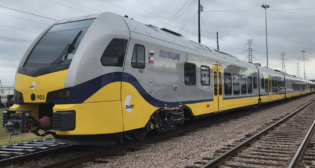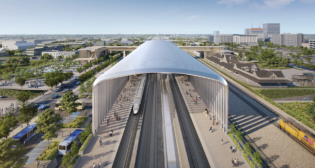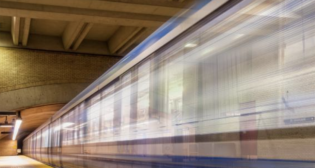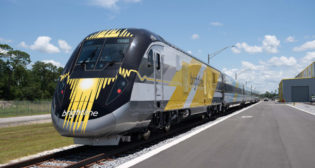
Transit Briefs: NYMTA, Sound Transit, TransLink, Tren Maya
Written by Marybeth Luczak, Executive Editor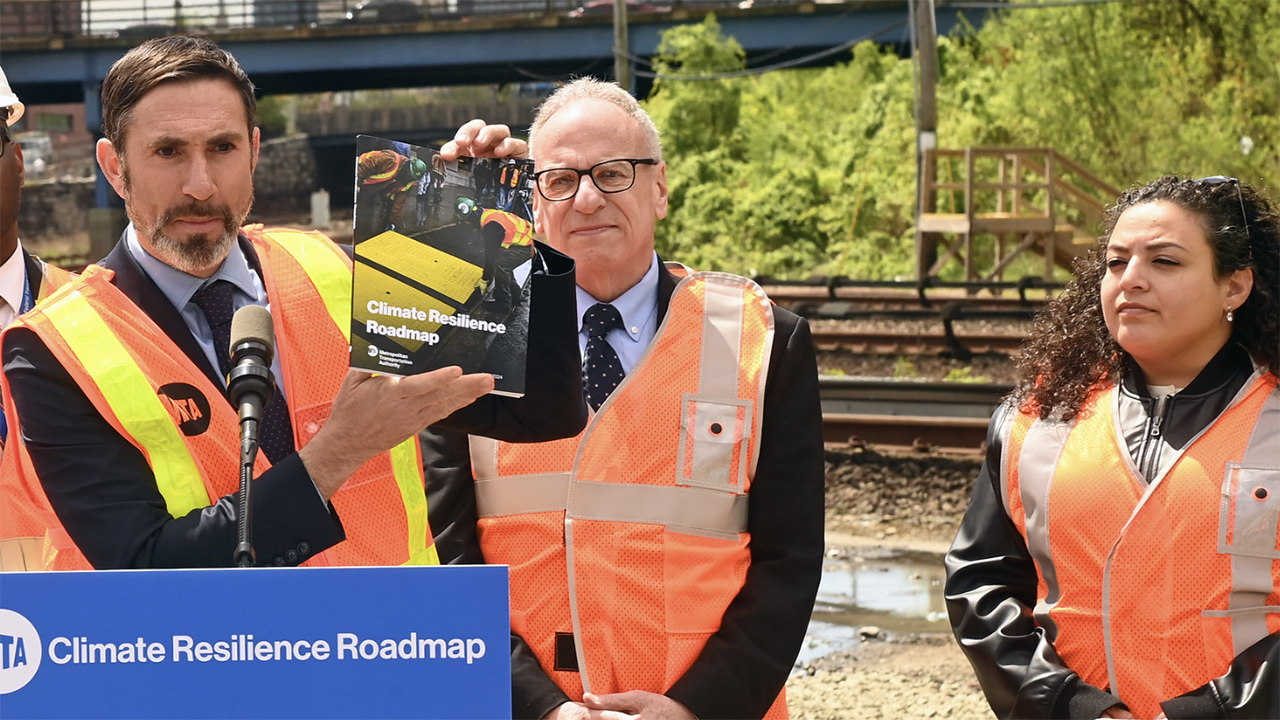
MTA Chair and CEO Janno Lieber and MTA Construction and Development President Jamie Torres-Springer (pictured, left) on April 25 announced the agency’s Climate Resilience Roadmap at the Metro-North Railroad Mott Haven Yard. (Marc A. Hermann / MTA)
New York Metropolitan Transportation Authority (NYMTA) unveils its Climate Resiliency Roadmap. Also, Washington’s Central Puget Sound Regional Transit Authority (Sound Transit) earns a sustainability award for its Federal Way Link light rail extension; metro-Vancouver’s TransLink approves a 2024 investment plan to address overcrowding; and the final sections of Mexico’s Tren Maya project are expected to be completed in August.
NYMTA
MTA on April 25 released a Climate Resilience Roadmap (see above). Developed in response to the “demonstrated and urgent need to address climate-related threats,” the agency said the document includes a climate vulnerability assessment; 10 core climate resilience goals to help MTA address threats to its infrastructure; and an implementation framework consisting of capital plan integration, resilient design practices, proactive operating actions, and better coordination between partner agencies.
Key strategies and actions include protecting the subway system from flooding, reducing coastal and rainfall flooding on Metro-North Railroad and Long Island Rail Road, and guarding infrastructure from extreme heat. MTA reported that the capital costs associated with this work are estimated to be as much as $6 billion over the next 10 years.
According to MTA, the necessary interventions include:
- “Shielding subways from torrential rain by installing mitigations like raised steps and elevated street vents to prevent stormwater from entering the subway system.
- “Investing in subway drainage and pumping equipment to remove stormwater that does enter the system.
- “Protecting subway yards and bus depots by elevating sensitive equipment above anticipated flood depths in areas that must remain operational during weather-related emergencies.
- “Addressing heat impacts on bridges by continuing existing efforts to protect metallic components from expansion due to prolonged heat exposure.
- “Advancing proactive measures to reduce the impacts of monthly tidal floods and rain on regional railroad infrastructure exacerbated by climate change-induced sea level rise.”
The Climate Resilience Roadmap’s release follows the MTA’s fall 2023 release of a 20-Year Needs Assessment.
“This document exemplifies the MTA’s commitment to protecting our system from the effects of global warming,” MTA Construction and Development President Jamie Torres-Springer said. “Climate change doesn’t recognize jurisdictional boundaries. We’re eager to partner with municipal agencies across the region to ensure that our transit infrastructure is protected from the extreme weather events we can anticipate due to climate change.”
“Many of the facilities that are behind the scenes for riders, like the Mott Haven Yard, have been affected by coastal flooding and heavy rainfall, and extreme weather events can completely shut down the railroad, inconveniencing thousands of customers,” MTA Metro-North Railroad President Catherine Rinaldi said. “Making resiliency investments in our train yards, maintenance shops, and power and signal systems give us the ability to rebound quickly after future storms and continue to provide safe and reliable service in all kinds of weather.”
Sound Transit
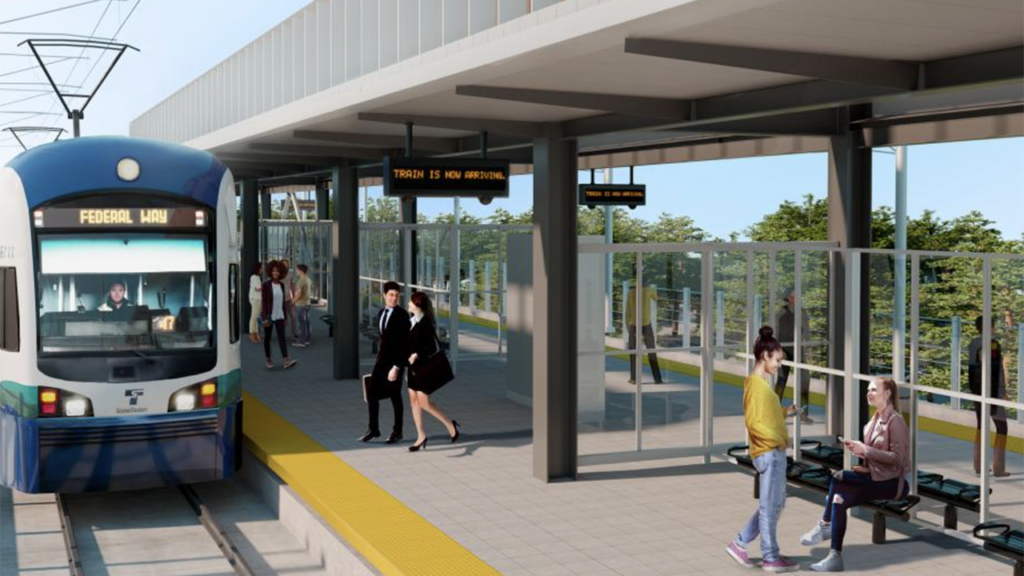
The Institute for Sustainable Infrastructure (ISI) has awarded an Envision Platinum award for sustainable infrastructure to Sound Transit’s Federal Way Link Extension project for “going above and beyond to deliver improvements to the social, economic, and environmental conditions of its community,” the transit agency reported April 25. Envision is described as “an internationally recognized rating system for sustainable infrastructure projects.”
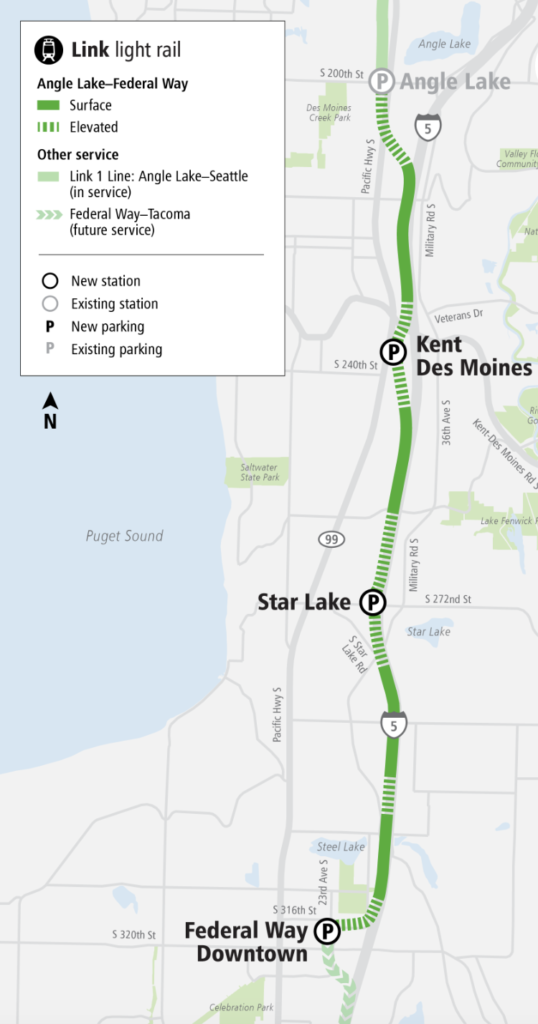
The Federal Way Link Extension, slated for completion in 2026, will run 7.8 miles from the Angle Lake Station in the city of SeaTac to the Federal Way Transit Center. It includes three stations in Kent/Des Moines near Highline College, South 272nd Street, and the Federal Way Transit Center.
The Envision Platinum Award was issued following a “comprehensive independent peer-review process conducted and overseen by ISI that verified the project accomplishments,” Sound Transit said. The evaluation assessed the project’s performance across 64 sustainability criteria, addressing community, quality of life, management, planning, materials, energy, water, environmental impacts, emissions, and resilience.
The design-build contract for Federal Way Link Extension stipulated the need for the project to attain at least an Envision Gold award level, according to the transit agency. Through the combined efforts of the Sound Transit project team and sustainability group and Parsons, the project’s lead design team, and design-build contractor Kiewit, platinum was achieved.
This is Sound Transit’s second project and the Pacific Northwest’s second transit project to receive verification by ISI, and the seventh Envision Platinum-rated transit project in the nation. The Downtown Redmond Link Extension was the first Sound Transit project to complete Envision verification; it received the Envision Platinum award in 2022.
Sound Transit said it anticipates pursuing Envision verification for all its future light rail expansion projects.
“We are honored to present the Envision Platinum award to the Federal Way Link Extension project, recognizing its outstanding commitment to sustainability, equity and resilience,” said Kristi Wamstad, ISI’s Verification Director. “This achievement underscores the project team’s dedication to creating a transit system that prioritizes environmental stewardship and social equity while meeting the needs of the community.”
“This award is a testament to Sound Transit’s long and deep commitment to sustainability and to the high levels of collaboration achieved with our project partners during challenging times,” Sound Transit CEO Goran Sparrman said. “We are proud of this achievement and look forward to many more sustainability milestones as we build public transit that connects our region to the places we live and work.”
“Our contribution to the Federal Way Extension project represents Parsons’ combined engineering expertise and enterprise-wide commitment to sustainability,” said Mark Fialkowski, President, Infrastructure North America for Parsons. “We are honored to be part of the team that achieved this award by creating a lasting, valuable public asset for the region and community.”
“Kiewit is proud to be the design-build contractor for Sound Transit’s Federal Way Link Extension, a project that showcases innovation in sustainable infrastructure,” said Kiewit Corporation Executive Vice President Doug Glaser. “Strong partnerships, particularly with the community, are essential to our success. We would not be able to accomplish what we did without the remarkable people we had on the team, including the 400 local union tradespeople and the 200 subcontractors and suppliers who came together with our construction and engineering staff to achieve a common goal.”
TransLink
Metro-Vancouver’s TransLink on April 25 reported that its 2024 Investment Plan (see above; scroll down in document) has been approved by the Mayors’ Council and the TransLink Board as a short-term plan to address overcrowding. It includes some initial increases in bus and rail services.
The following improvements will begin rolling out later this year:
- Increasing frequencies for SkyTrain’s Canada Line, which runs between downtown Vancouver, the Vancouver International Airport, and Richmond.
- Increasing service on 60 bus routes to address overcrowding.
- Extending evening hours on 11 bus routes.
- Expanding the bus fleet to prepare for Bus Rapid Transit.
- Earlier SeaBus sailings by 15 minutes on weekdays.
- Improving late-evening HandyDART service.
- Investing in road safety and new cycling and walking infrastructure.
- Adding new bus priority infrastructure.
According to TransLink, the plan includes up to $300 million in capital funding from the government of British Columbia to support the purchase of new buses for future service increases. TransLink said it will work with senior government partners on a 2025 Investment Plan to help identify a new long-term funding model for transit.
“The 2024 Investment Plan provides critical transit expansion on our most overcrowded routes for the first time since 2019,” TransLink CEO Kevin Quinn said. “As we implement this short-term solution, it is critical that we simultaneously look to the future and work with all levels of government to develop a funding model that is capable of supporting transit investments that keep up with our rapid population growth.”
“This Investment Plan is a solid and necessary first step in improving how people get around this region, but we also need to be thinking long-term,” Mayors’ Council Chair Brad West said. “Work is under way on a 2025 Investment Plan, and I look forward to working with both the federal and provincial governments on a new transit funding model that supports long-term growth as metro Vancouver’s population rapidly expands.”
Tren Maya
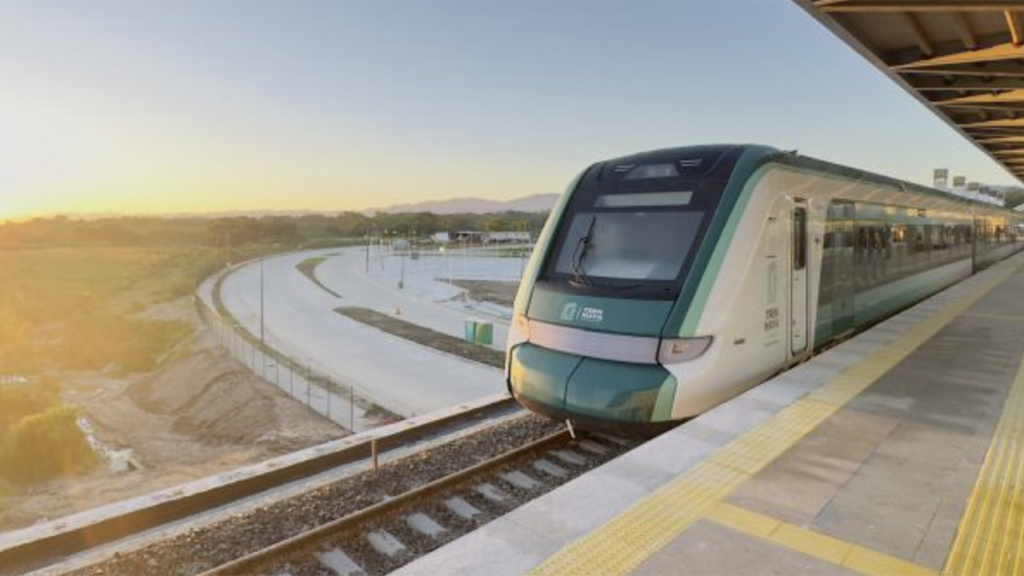
Mexican President Andrés Manuel López Obrador has announced that the 947-mile Tren Maya project’s final sections—5 south (Playa del Carmen to Tulum), 6 (Tulum to Bacalar) and 7 (Bacalar to Escárcega, Campeche)—will be inaugurated at the end of August, according to a Riviera Maya News report. The entire project was initially planned for inauguration at the end of February; then López Obrador told local media that the opening of the remaining sections would be delayed by the upcoming general election on June 2, which he had previously set himself as the deadline for completing the project in full.
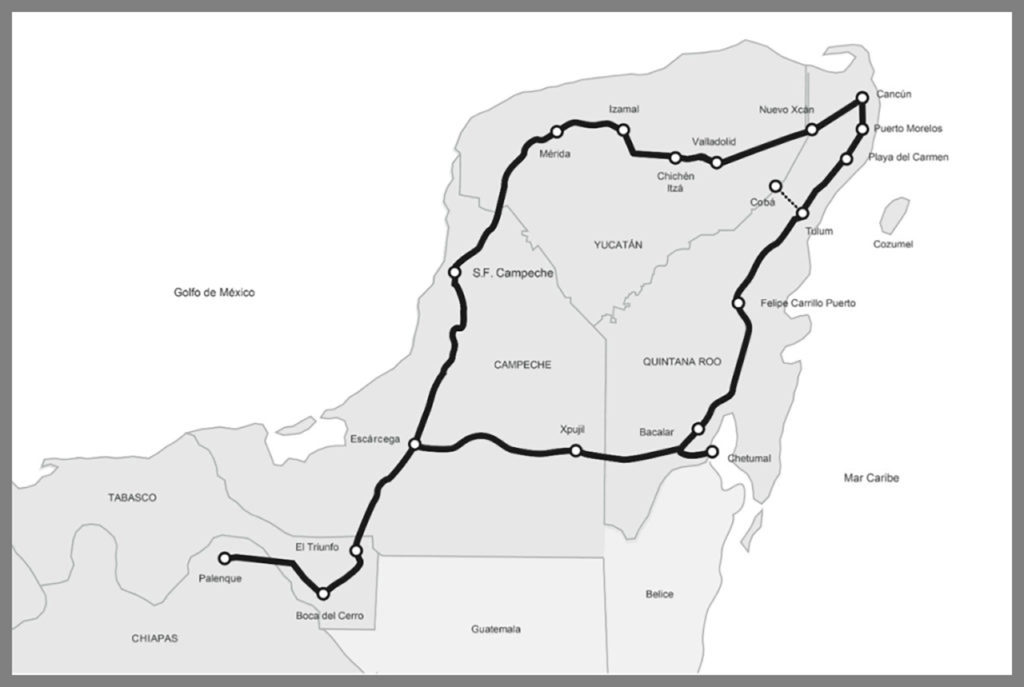
“We are working from Playa del Carmen to Escárcega,” the President said during an April 22 press conference, Riviera Maya News reported. “It is a great project done in record time. It is going to be completely finished even though we are facing problems.”
According to the new source, “he said that section [5 south] has cost the most to build due to the karst nature of the soil and the concentration of a large number of cenotes and underground rivers. To avoid further damage to the subsoil he said approximately 80 kilometers of track is being built above ground on a viaduct.” Also causing delays, the President said, is construction of a “200-meter cable-stayed bridge.”
“We are not going to fix columns,” López Obrador said, according to the news source. “It is going to be a cable-stayed bridge and this means a delay for us. This bridge alone, it could have been drilled and the piles put in, but we said no, we are going to take care of the area and that is why the bridge.”
According to the Riviera Maya News, the President addressed “water contamination allegations made by environmentalists along section 5,” reporting that, “‘We had a problem in a cave when placing a column… we are already cleaning, repairing everything and solving the problem’ … without providing details.”
Alstom was selected to supply 42 X’trapolis trainsets for the Tren Maya project.
Further Reading:
- Next Section of Mexico’s Mayan Train Opens
- Report: Tren Maya Inauguration Pushed to June
- Alstom Delivers First Tren Maya Equipment
- Tren Maya Opening December 2023
- Mayan Train Extended to Palenque
- Mexican President Opens First Section of Mayan Train
- First Section of Mayan Train to Open Dec. 15
